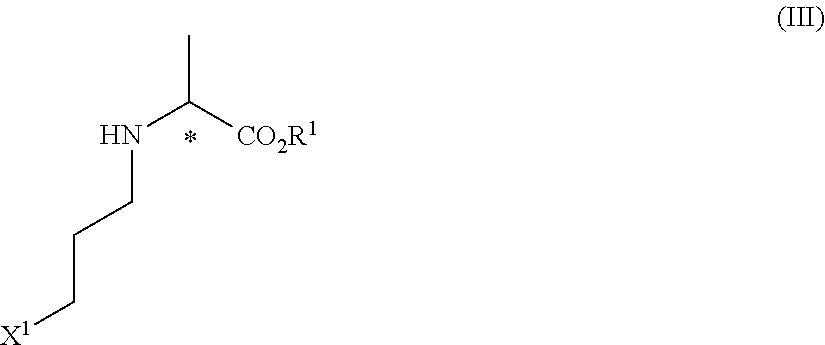Method of producing optically active N-(halopropyl) amino acid derivative
a technology of n-(halopropyl) and amino acid derivatives, which is applied in the preparation of carbamic acid derivatives, bulk chemical production, organic chemistry, etc., can solve the problem of maintaining optical activity, and achieve the effect of inexpensively and efficiently producing
- Summary
- Abstract
- Description
- Claims
- Application Information
AI Technical Summary
Benefits of technology
Problems solved by technology
Method used
Image
Examples
example 1
Synthesis of (R)—N-(3-chloropropyl)alanine ethyl ester hydrochloride
[0048]According to the reaction scheme below, the hydrochloride of (R)—N-(3-chloropropyl)alanine ethyl ester 3 (hereinafter sometimes simply referred to as the “hydrochloride 3”) was obtained from D-alanine ethyl ester hydrochloride 1 and 1-bromo-3-chloropropane 2.
[0049]
[0050]Acetonitrile (380 mL), potassium carbonate (59.91 g; 0.419 mol), and 1-bromo-3-chloropropane 2 (180 g; 1.14 mol) were added to D-alanine ethyl ester hydrochloride 1 (58.54 g; 0.381 mol). A reaction was carried out while stirring at 50° C. for 9 hours. The reaction mixture was sampled, ethyl acetate and water were added thereto, the collected organic layer was analyzed by GC, and the reaction was finished after confirming that the peak derived from the D-alanine ethyl ester had disappeared (each peak in GC was: 1-bromo-3-chloropropane 2: 7.2 minutes, D-alanine ethyl ester: 7.4 minutes, and (R)—N-(3-chloropropyl)alanine ethyl ester: 16.1 minutes)...
example 2
Formation of tert-butoxycarbonyl of hydrochloride 3 (formation of Boc compound)
[0057]According to the reaction scheme below, the hydrochloride 3 obtained in Example 1 was converted into a Boc compound to introduce a protecting group onto the nitrogen atom.
[0058]
[0059]Ethyl acetate (200 mL) and an aqueous solution (220 mL) of potassium carbonate (22.5 g; 0.163 mol) were added to hydrochloride 3 (62.5 g; 0.272 mol).
[0060]Then, an ethyl acetate solution (70 mL) of di-tert-butyl dicarbonate (Boc2O) (59.4 g; 0.272 mol) was added dropwise for 5 minutes, and then stirred at room temperature for 7 hours. The ethyl acetate layer in the reaction mixture was sampled and analyzed by GC, and the reaction was finished after confirming that the peak derived from (R)—N-(3-chloropropyl)alanine ethyl ester had disappeared (each peak in GC was: (R)—N-(3-chloropropyl)alanine ethyl ester: 16.1 minutes and (R)—N-(3-chloropropyl)-N-(tert-butoxycarbonyl)alanine ethyl ester 4: 20.0 minutes).
[0061]After the ...
example 3
[0064]According to the reaction scheme below, the hydrochloride 3 obtained in Example 1 was benzoylated to introduce a protecting group onto the nitrogen atom.
[0065]
[0066]Hydrochloride 3 (4 g; 17.4 mmol), ethyl acetate (20 mL), and an aqueous solution (20 mL) of sodium hydrogencarbonate (3.65 g; 43.5 mmol) were mixed, and an ethyl acetate layer was collected. Then, 20 mL of ethyl acetate was added to the remaining aqueous layer, and an ethyl acetate layer was collected again. Then, the obtained ethyl acetate layers were combined and evaporated at 50° C. under a reduced pressure of 60 mmHg, thereby giving 3.39 g of free (R)—N-(3-chloropropyl)alanine ethyl ester.
[0067]Then, ethyl acetate (20 mL) and triethylamine (2.64 g; 26.1 mmol) were added to the resultant free (R)—N-(3-chloropropyl)alanine ethyl ester (3.39 g). Then, an ethyl acetate solution (20 mL) of benzoyl chloride (BzCl) (2.69 g, 19.1 mmol) was added dropwise for 15 minutes. Since solids precipitated when BzCl was added dro...
PUM
| Property | Measurement | Unit |
|---|---|---|
| atomic number | aaaaa | aaaaa |
| optical purity | aaaaa | aaaaa |
| optical purity | aaaaa | aaaaa |
Abstract
Description
Claims
Application Information
 Login to View More
Login to View More - R&D
- Intellectual Property
- Life Sciences
- Materials
- Tech Scout
- Unparalleled Data Quality
- Higher Quality Content
- 60% Fewer Hallucinations
Browse by: Latest US Patents, China's latest patents, Technical Efficacy Thesaurus, Application Domain, Technology Topic, Popular Technical Reports.
© 2025 PatSnap. All rights reserved.Legal|Privacy policy|Modern Slavery Act Transparency Statement|Sitemap|About US| Contact US: help@patsnap.com



